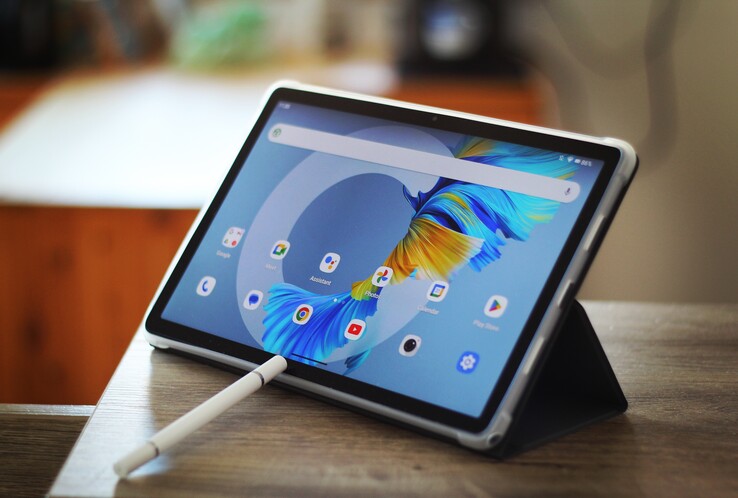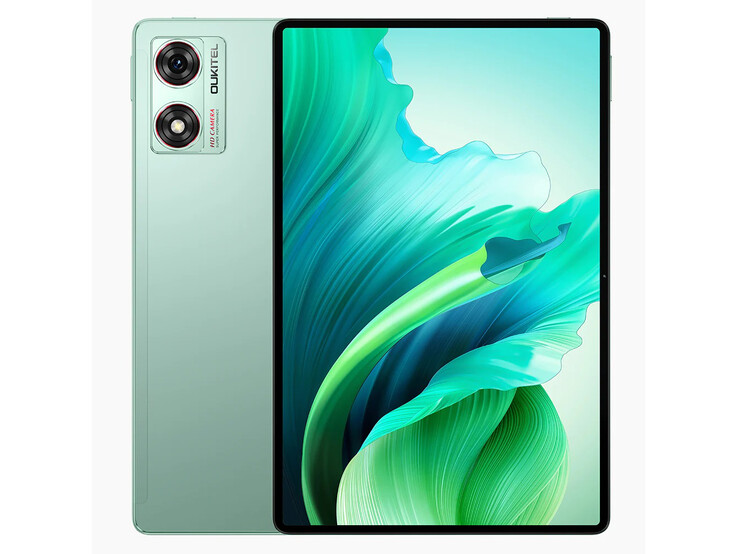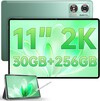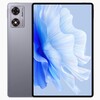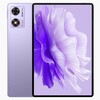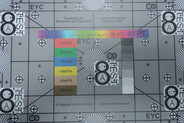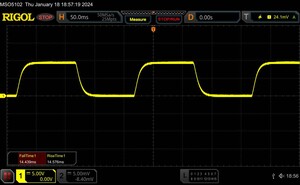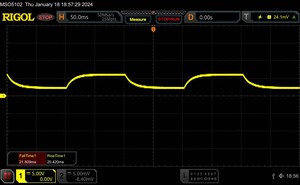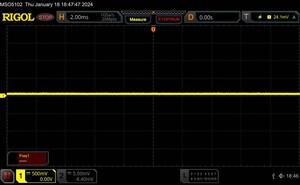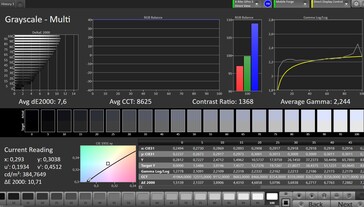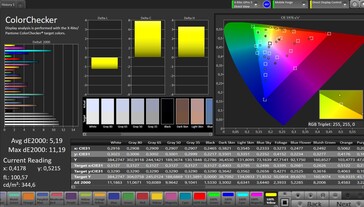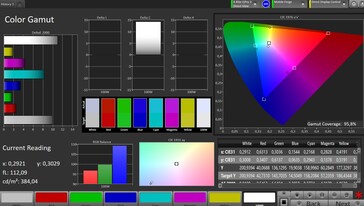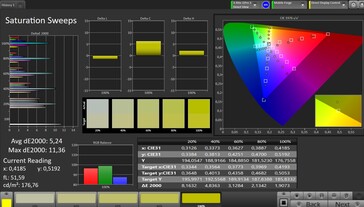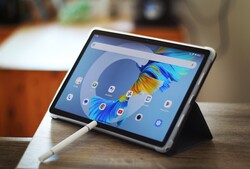Oukitel OT8 review - Budget tablet with long battery life, LTE and plenty of space
Possible competitors in comparison
Bewertung | Datum | Modell | Gewicht | Laufwerk | Groesse | Aufloesung | Preis ab |
|---|---|---|---|---|---|---|---|
| 81.3 % v7 (old) | 03 / 2024 | Oukitel OT8 T7200 (T606), Mali-G57 MP1 | 515 g | 256 GB UFS 2.2 Flash | 11.00" | 1920x1200 | |
| 84.2 % v7 (old) | 02 / 2024 | Samsung Galaxy Tab A9+ SD 695 5G, Adreno 619 | 480 g | 64 GB UFS 2.2 Flash | 11.00" | 1920x1200 | |
| 83.5 % v7 (old) | 01 / 2024 | Xiaomi Redmi Pad SE SD 680, Adreno 610 | 481 g | 128 GB eMMC Flash | 11.00" | 1920x1200 | |
| 79.3 % v7 (old) | 01 / 2024 | Teclast T40 HD T7200 (T606), Mali-G57 MP1 | 462 g | 128 GB UFS 2.0 Flash | 10.36" | 2000x1200 |
Case and features - Metal chassis creaks from time to time
Our test sample of the Oukitel OT8 is encased in a grey metal frame and has a back in the same color, also made of metal. The camera module with its two massive openings has shiny red accents. Behind it is only a much smaller camera lens and the LED flash.
The design looks modern, and the edges around the screen on the front are not too wide either. This means you can still hold the tablet comfortably in your hand without constantly accidentally touching the touchscreen.
The stability of the case is rather mediocre: if you twist the tablet a little, you can hear a distinct clicking noise, and the screen module sometimes shifts slightly under the frame. However, the rigidity is okay for the price range, and the workmanship is fine.
The tablet comes with 6 GB of RAM, which is quite ample compared to similarly priced tablets. You also rarely see 256 GB of mass storage in this price range. There is no NFC, but the two SIM slots are on board, which means that a mobile network for Internet access and even phone calls is available.
The microSD slot shares a slot with a SIM card. Here you have to decide whether you would use a dual SIM or a SIM and a microSD card. Overall, the card reader performs at a class-leading level in terms of transfer rates in conjunction with our Angelbird V60 reference card. However, the Samsung Galaxy Tab A9+ shows that even higher data rates are possible here.
| SD Card Reader - average JPG Copy Test (av. of 3 runs) | |
| Samsung Galaxy Tab A9+ (Angelbird AV Pro V60) | |
| Average of class Tablet (10.2 - 57.4, n=51, last 2 years) | |
| Teclast T40 HD (Angelbird V60) | |
| Oukitel OT8 (Angelbird V60) | |
| Xiaomi Redmi Pad SE (Angelbird AV Pro V60) | |
Cross Platform Disk Test (CPDT)
Communication, software and operation - With LTE support
The tablet offers WiFi 5 as the fastest standard. In our tests with the Asus ROG Rapture AXE11000 reference router, the data rates via Wi-Fi are at a class level of around 300 - 350 MBit/s and relatively stable, even after several repetitions. The tablet cannot fully utilize a gigabit Internet connection, but the WLAN is fast enough for everyday use without large downloads.
The LTE network can also be used for Internet access, and several frequencies are available. However, when traveling further, especially to the USA or Mexico, you should check whether the tablet supports the corresponding bands, which Oukitel also recommends on its website. During our test, the reception in urban areas was good but not quite at the level of high-end smartphones.
The manufacturer installs Android 13 on the tablet and hardly makes any changes to the system. The security patches were from November 2023 at the time of testing, and are therefore older. Third-party software is not pre-installed. Fortunately, the tablet supports Google's DRM standard Widevine L1, so streaming services can be viewed without resolution restrictions.
Although the touchscreen only works with a maximum sampling rate of 120 Hz and the display can only show a maximum of 60 frames per second, operation is still reasonably smooth. The low system performance, which occasionally leads to waiting times when unlocking, is more of a hindrance.
A stylus is included in the package, although this is only a passive model, i.e. without a Bluetooth connection to the device. You can use it to make entries and navigate more precisely than with your finger. However, there is no pressure level recognition, for example, for different brush strokes in painting and drawing apps.
The inexpensive tablet does not have a fingerprint sensor but does have facial recognition via the front camera. This works without an infrared sensor, so it is not quite as secure as more expensive solutions. However, it works reliably and reasonably quickly once a face has been stored.
| Networking | |
| iperf3 transmit AXE11000 | |
| Xiaomi Redmi Pad SE | |
| Samsung Galaxy Tab A9+ | |
| Teclast T40 HD | |
| Oukitel OT8 | |
| iperf3 receive AXE11000 | |
| Samsung Galaxy Tab A9+ | |
| Xiaomi Redmi Pad SE | |
| Teclast T40 HD | |
| Oukitel OT8 | |
Camera - The selfie camera takes decent pictures
The tablet has a 13-megapixel camera on the back. It does not take very detailed pictures, which are also not very sharp. As the light intensity decreases, details are increasingly lost in darker areas while the remaining light sources are outshining.
Videos can be recorded at a maximum of 1080p and 30 fps. The autofocus sometimes takes quite a long time to adjust to changing conditions. Exposure compensation is also not the fastest. Overall, the videos are not very colorful and quickly appear blurred and unappealing, especially in less-than-ideal lighting conditions.
The selfie camera is hidden in the frame above the screen on the front. The resulting images are usable, but a coarse grain in the photo quickly becomes noticeable when enlarged. Otherwise, however, the detail reproduction is decent.
Image comparison
Choose a scene and navigate within the first image. One click changes the position on touchscreens. One click on the zoomed-in image opens the original in a new window. The first image shows the scaled photograph of the test device.
Main cameraMain cameraLow Light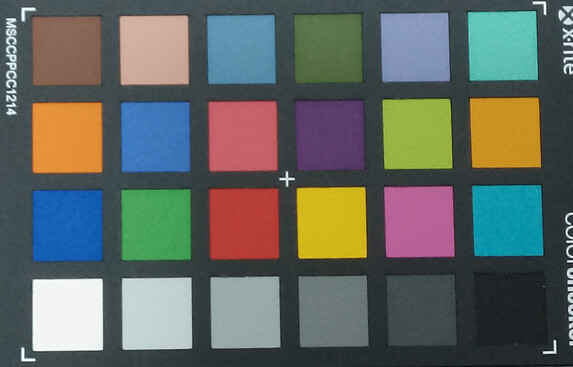

Display - Not quite as bright
With its 11-inch display and a Full HD resolution slightly expanded to 16:10 format, the screen is on par with similarly priced tablets. However, the maximum brightness is less than 400 cd/m², which makes the device inferior to Samsung or Xiaomi.
As long as you are indoors, this will usually not be a major issue, but in the garden or outside in a café, the resulting reflections on the display can make it difficult to see the screen content.
We did not notice PWM flickering even at very low brightness levels. In our tests with the spectrophotometer and the CalMAN software, we detected a clear blue cast in the display, with bright blue and green tones in particular being quite distorted. Overall, the colors appear somewhat dull.
| |||||||||||||||||||||||||
Brightness Distribution: 88 %
Center on Battery: 390 cd/m²
Contrast: 1500:1 (Black: 0.26 cd/m²)
ΔE ColorChecker Calman: 5.19 | ∀{0.5-29.43 Ø4.78}
ΔE Greyscale Calman: 7.6 | ∀{0.09-98 Ø5}
95.8% sRGB (Calman 2D)
Gamma: 2.244
CCT: 8625 K
| Oukitel OT8 IPS, 1920x1200, 11" | Samsung Galaxy Tab A9+ TFT-LCD, 1920x1200, 11" | Xiaomi Redmi Pad SE TFT-LCD, 1920x1200, 11" | Teclast T40 HD IPS, 2000x1200, 10.4" | |
|---|---|---|---|---|
| Response Times | -16% | -3% | 1% | |
| Response Time Grey 50% / Grey 80% * (ms) | 42.2 ? | 53.81 ? -28% | 47.92 ? -14% | 44 ? -4% |
| Response Time Black / White * (ms) | 29 ? | 29.92 ? -3% | 26.38 ? 9% | 27.4 ? 6% |
| PWM Frequency (Hz) | ||||
| Screen | -3% | 24% | -22% | |
| Brightness middle (cd/m²) | 390 | 493 26% | 473 21% | 367 -6% |
| Brightness (cd/m²) | 376 | 460 22% | 449 19% | 346 -8% |
| Brightness Distribution (%) | 88 | 90 2% | 85 -3% | 90 2% |
| Black Level * (cd/m²) | 0.26 | 0.35 -35% | 0.28 -8% | 0.4 -54% |
| Contrast (:1) | 1500 | 1409 -6% | 1689 13% | 918 -39% |
| Colorchecker dE 2000 * | 5.19 | 6 -16% | 3 42% | 6.54 -26% |
| Colorchecker dE 2000 max. * | 11.19 | 11.7 -5% | 6 46% | 14.53 -30% |
| Greyscale dE 2000 * | 7.6 | 8.2 -8% | 2.7 64% | 8.7 -14% |
| Gamma | 2.244 98% | 2.21 100% | 2.27 97% | 2.169 101% |
| CCT | 8625 75% | 9131 71% | 6589 99% | 7952 82% |
| Total Average (Program / Settings) | -10% /
-5% | 11% /
19% | -11% /
-17% |
* ... smaller is better
Display Response Times
| ↔ Response Time Black to White | ||
|---|---|---|
| 29 ms ... rise ↗ and fall ↘ combined | ↗ 14.4 ms rise | |
| ↘ 14.6 ms fall | ||
| The screen shows relatively slow response rates in our tests and may be too slow for gamers. In comparison, all tested devices range from 0.1 (minimum) to 240 (maximum) ms. » 76 % of all devices are better. This means that the measured response time is worse than the average of all tested devices (20.2 ms). | ||
| ↔ Response Time 50% Grey to 80% Grey | ||
| 42.2 ms ... rise ↗ and fall ↘ combined | ↗ 21.8 ms rise | |
| ↘ 20.4 ms fall | ||
| The screen shows slow response rates in our tests and will be unsatisfactory for gamers. In comparison, all tested devices range from 0.165 (minimum) to 636 (maximum) ms. » 69 % of all devices are better. This means that the measured response time is worse than the average of all tested devices (31.6 ms). | ||
Screen Flickering / PWM (Pulse-Width Modulation)
| Screen flickering / PWM not detected | |||
In comparison: 53 % of all tested devices do not use PWM to dim the display. If PWM was detected, an average of 8101 (minimum: 5 - maximum: 343500) Hz was measured. | |||
Performance, emissions and battery life - More power would be good
The Unisoc T606 is not exactly known as a performance champion and tends to be used in very inexpensive cell phones and tablets. This means that the Oukitel OT8 is usually only at the bottom of the comparison field. The graphics performance is also low, so gamers should look elsewhere.
The memory, on the other hand, is surprisingly fast: The manufacturer relies on UFS 2.2 flash, which is also used in many mid-range cell phones and helps tablet to clearly outperform the comparison devices. The slow processor does not always make quick loading times possible here either, but the fast internal memory can at least compensate for the deficits a little.
Heating under prolonged load is hardly noticeable on the case surface, and the 3DMark stress tests also show that the performance remains at a very stable level.
The tablet has four speakers, and they can get quite loud. They also sound decent overall and can even make some low mids audible. External audio devices can also be connected via the 3.5 mm jack or Bluetooth 5.0. With aptX HD and LDAC, two higher-quality codecs are also supported for wireless audio transmission.
At 8,800 mAh, the battery has a very high capacity and also achieved very good runtimes of just over 18 hours in our WLAN test. This means that nothing should stand in the way of a rainy day with the Oukitel OT8 without charging. If the tablet does need to be plugged in, it can be charged with up to 18 watts; a full charge takes approximately 4 hours.
| Octane V2 - Total Score | |
| Average of class Tablet (763 - 138481, n=95, last 2 years) | |
| Samsung Galaxy Tab A9+ | |
| Xiaomi Redmi Pad SE | |
| Teclast T40 HD | |
| Oukitel OT8 | |
| Average Unisoc T7200 (T606) (2228 - 13705, n=15) | |
| Oukitel OT8 | Samsung Galaxy Tab A9+ | Xiaomi Redmi Pad SE | Teclast T40 HD | Average 256 GB UFS 2.2 Flash | Average of class Tablet | |
|---|---|---|---|---|---|---|
| AndroBench 3-5 | -29% | -51% | -37% | 15% | 71% | |
| Sequential Read 256KB (MB/s) | 930 | 485.96 -48% | 297.47 -68% | 688.9 -26% | 892 ? -4% | 1778 ? 91% |
| Sequential Write 256KB (MB/s) | 606 | 476.37 -21% | 228.97 -62% | 188 -69% | 718 ? 18% | 1329 ? 119% |
| Random Read 4KB (MB/s) | 162.2 | 130.67 -19% | 102.41 -37% | 137 -16% | 224 ? 38% | 244 ? 50% |
| Random Write 4KB (MB/s) | 224.7 | 162.9 -28% | 146.92 -35% | 143.8 -36% | 244 ? 9% | 278 ? 24% |
Temperature
(+) The maximum temperature on the upper side is 32.6 °C / 91 F, compared to the average of 33.7 °C / 93 F, ranging from 20.7 to 53.2 °C for the class Tablet.
(+) The bottom heats up to a maximum of 29.5 °C / 85 F, compared to the average of 33.2 °C / 92 F
(+) In idle usage, the average temperature for the upper side is 22.9 °C / 73 F, compared to the device average of 30 °C / 86 F.
3DMark Wild Life Stress Test
Loudspeaker
Oukitel OT8 audio analysis
(+) | speakers can play relatively loud (86.1 dB)
Bass 100 - 315 Hz
(-) | nearly no bass - on average 27.7% lower than median
(±) | linearity of bass is average (10.1% delta to prev. frequency)
Mids 400 - 2000 Hz
(±) | higher mids - on average 5.8% higher than median
(+) | mids are linear (6.7% delta to prev. frequency)
Highs 2 - 16 kHz
(+) | balanced highs - only 3.9% away from median
(±) | linearity of highs is average (8.1% delta to prev. frequency)
Overall 100 - 16.000 Hz
(±) | linearity of overall sound is average (19.3% difference to median)
Compared to same class
» 53% of all tested devices in this class were better, 5% similar, 42% worse
» The best had a delta of 7%, average was 20%, worst was 129%
Compared to all devices tested
» 46% of all tested devices were better, 8% similar, 47% worse
» The best had a delta of 4%, average was 24%, worst was 134%
Teclast T40 HD audio analysis
(±) | speaker loudness is average but good (74.4 dB)
Bass 100 - 315 Hz
(-) | nearly no bass - on average 25.7% lower than median
(±) | linearity of bass is average (8.6% delta to prev. frequency)
Mids 400 - 2000 Hz
(+) | balanced mids - only 4.7% away from median
(±) | linearity of mids is average (8.3% delta to prev. frequency)
Highs 2 - 16 kHz
(+) | balanced highs - only 3.1% away from median
(±) | linearity of highs is average (8% delta to prev. frequency)
Overall 100 - 16.000 Hz
(±) | linearity of overall sound is average (24.5% difference to median)
Compared to same class
» 75% of all tested devices in this class were better, 7% similar, 18% worse
» The best had a delta of 7%, average was 20%, worst was 129%
Compared to all devices tested
» 74% of all tested devices were better, 6% similar, 21% worse
» The best had a delta of 4%, average was 24%, worst was 134%
Battery life
| Battery Runtime - WiFi Websurfing | |
| Oukitel OT8 | |
| Xiaomi Redmi Pad SE | |
| Samsung Galaxy Tab A9+ | |
| Teclast T40 HD | |
| Average of class Tablet (6.67 - 24.2, n=96, last 2 years) | |
Pros
Cons
Verdict - Oukitel tablet with good features
The Oukitel OT8 offers several highlights in its price range under 200 euros: First of all, there is very large and fast mass storage, which is supported by 6 GB of RAM. There is pure Android, a stylish metal casing, and mobile network support thanks to 2 SIM slots. The four speakers provide a good sound, and the battery lasts a long time.
However, the tablet also proves to be a dazzler in some respects: the manufacturer claims 30 GB of RAM, for example, which can only be accessed via a 24 GB swap file in the internal memory. However, this would be comparatively slow and probably unnecessary for the vast majority of users. In addition, the included stylus is not a stylus as we know it from more expensive tablets, but merely a support for more precise inputs.
Apart from the really fast memory, the tablet's performance is clearly limited and only sufficient for basic everyday use. The cameras are a makeshift, and only the selfie camera on the front delivers passable results.
With the Oukitel OT8, you get a lot of features and long runtimes for your money. However, the tablet does not have a lot of performance reserves.
The Samsung Galaxy Tab A9+ is much faster and also guarantees updates for 4 years. However, you have to make do with less memory here.
Price and availability
The Oukitel OT8 can be purchased directly from the manufacturer for just under 160 euros.
At amazon.de, the tablet costs 199 euros at the time of testing, but there is a voucher for 20 euros that you can redeem.
Oukitel OT8
- 02/25/2024 v7 (old)
Florian Schmitt
Transparency
The selection of devices to be reviewed is made by our editorial team. The test sample was provided to the author as a loan by the manufacturer or retailer for the purpose of this review. The lender had no influence on this review, nor did the manufacturer receive a copy of this review before publication. There was no obligation to publish this review. As an independent media company, Notebookcheck is not subjected to the authority of manufacturers, retailers or publishers.
This is how Notebookcheck is testing
Every year, Notebookcheck independently reviews hundreds of laptops and smartphones using standardized procedures to ensure that all results are comparable. We have continuously developed our test methods for around 20 years and set industry standards in the process. In our test labs, high-quality measuring equipment is utilized by experienced technicians and editors. These tests involve a multi-stage validation process. Our complex rating system is based on hundreds of well-founded measurements and benchmarks, which maintains objectivity. Further information on our test methods can be found here.




